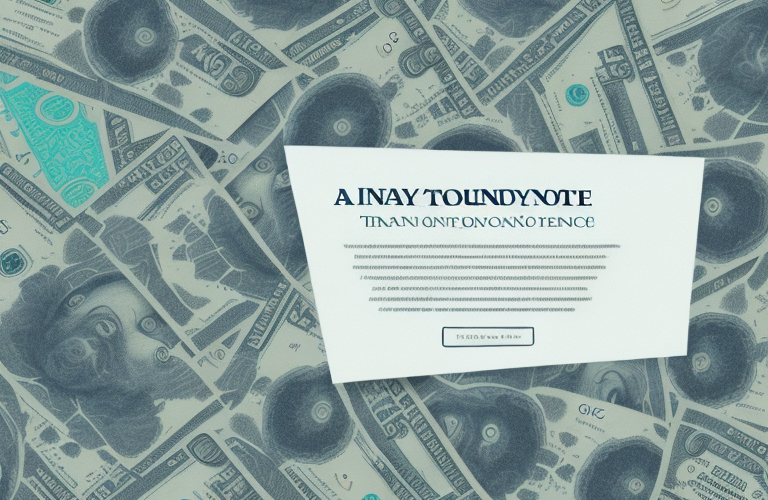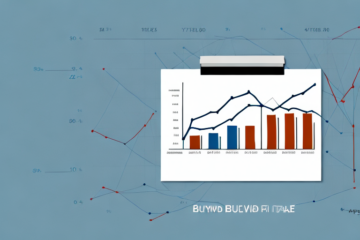Understanding 10-Year Treasury Notes: A Guide to Key Finance Terms
If you’re looking to invest in the world of finance, you might have heard of 10-year treasury notes. These long-term investments are a popular choice for those looking to earn steady returns over a decade. In this guide, we’ll walk you through everything you need to know about 10-year treasury notes, from their history and how they work, to their risks and benefits, as well as how to buy and sell them.
What are 10-Year Treasury Notes?
Before we delve into the intricacies of 10-year treasury notes, let’s first define what they are. Treasury notes are long-term debt securities issued by the US government, with maturities ranging from two to ten years. They’re considered some of the safest investments around, as they are backed by the full faith and credit of the US government. 10-year treasury notes, in particular, offer a fixed interest rate for the next decade, making them a popular investment choice for those looking for a stable and secure investment.
Investors often turn to 10-year treasury notes as a way to diversify their portfolio and reduce risk. These notes are also closely watched by economists and analysts as they can provide insight into the overall health of the economy. When demand for 10-year treasury notes is high, it can indicate that investors are seeking safe havens due to economic uncertainty. On the other hand, when demand is low, it can suggest that investors are more willing to take on riskier investments in search of higher returns.
How Do 10-year Treasury Notes Work?
When you purchase a 10-year Treasury note, you’re basically lending money to the US government over a period of ten years. In return, the government pays you interest on your investment, known as coupon payments, twice a year. At maturity, you receive the face value of the note back. The interest rate on these notes is fixed at the time of issuance and remains the same for the entire ten-year period. In this way, 10-year treasury notes are relatively straightforward investments that offer predictable returns.
One advantage of investing in 10-year Treasury notes is that they are considered to be very safe investments. This is because they are backed by the full faith and credit of the US government, which is considered to be one of the most creditworthy entities in the world. As a result, these notes are often used as a benchmark for other types of investments, such as corporate bonds.
Another important factor to consider when investing in 10-year Treasury notes is inflation. Because the interest rate on these notes is fixed, inflation can erode the value of your investment over time. However, if you hold the note until maturity, you will receive the full face value of the note, regardless of any changes in inflation. This makes 10-year Treasury notes a good option for investors who are looking for a low-risk, long-term investment.
The History of 10-Year Treasury Notes
The US Treasury Department first introduced treasury notes in 1877, with maturities ranging from one to five years. The notes were initially used as a way for the US government to finance its debts during the Civil War. Since then, treasury notes have evolved to offer longer maturities and fixed interest rates over the years, with 10-year treasury notes becoming a popular option for investors in the 1980s.
10-year treasury notes are considered a benchmark for long-term interest rates in the US. They are closely watched by investors and economists as an indicator of the overall health of the economy. The yield on 10-year treasury notes is often used as a reference point for setting mortgage rates, corporate bond rates, and other long-term borrowing rates. In times of economic uncertainty, investors tend to flock to 10-year treasury notes as a safe haven investment, driving down yields and lowering borrowing costs for the government and other borrowers.
Who Issues 10-Year Treasury Notes and Why?
The US Treasury Department is responsible for issuing 10-year treasury notes, in order to finance the national debt and fund government operations. The government relies on treasury notes as a way of financing long-term projects and expenses, such as infrastructure improvements and social welfare programs, among others. Investors purchase 10-year treasury notes as a way of contributing to the national debt while also earning reliable returns on their investments.
10-year treasury notes are considered a relatively safe investment, as they are backed by the full faith and credit of the US government. This means that investors are highly likely to receive their principal investment back, along with interest payments, upon maturity of the note. Additionally, 10-year treasury notes are often used as a benchmark for other interest rates, such as mortgage rates and corporate bond rates, making them an important indicator of the overall health of the economy.
The Role of the Federal Reserve in 10-Year Treasury Notes
The Federal Reserve is responsible for managing the US monetary system and has a direct impact on the pricing of 10-year treasury notes. When the Fed increases interest rates, the prices of existing bonds will fall, as bondholders will demand higher yields to compensate for the increased interest rate environment. Similarly, when the Federal Reserve lowers interest rates, the prices of existing bonds will rise, since bondholders will be willing to accept lower yields in an environment of lower interest rates.
Another way that the Federal Reserve can impact the pricing of 10-year treasury notes is through its open market operations. The Fed can buy or sell treasury securities in the open market, which can affect the supply and demand for these securities. If the Fed buys a large amount of treasury securities, it can increase demand for these securities and drive up their prices, which can lower their yields. Conversely, if the Fed sells a large amount of treasury securities, it can increase the supply of these securities and drive down their prices, which can increase their yields.
It’s important to note that the Federal Reserve’s actions and statements can also impact market expectations for future interest rates, which can affect the pricing of 10-year treasury notes. For example, if the Fed signals that it plans to raise interest rates in the future, bondholders may demand higher yields on 10-year treasury notes to compensate for the expected increase in interest rates. On the other hand, if the Fed signals that it plans to keep interest rates low for an extended period of time, bondholders may be willing to accept lower yields on 10-year treasury notes.
How Are 10-Year Treasury Notes Priced?
The price of a 10-year treasury note at any given time is influenced by several factors, including the economy, inflation rates, and global demand for US debt. When there is high demand for US government bonds, the price of the bonds will increase and the yield, or interest rate, will decrease. Conversely, when demand is low, the price of the bonds will decrease, and the yield will increase.
Another factor that can affect the price of 10-year treasury notes is the actions of the Federal Reserve. The Federal Reserve can influence interest rates by buying or selling government bonds, which can impact the demand for these bonds and ultimately affect their price. Additionally, changes in monetary policy by the Federal Reserve, such as raising or lowering interest rates, can also impact the price of 10-year treasury notes.
Risks and Benefits of Investing in 10-Year Treasury Notes
Like any investment, 10-year treasury notes come with both risks and benefits. One of the primary benefits of investing in these notes is the secure and stable nature of the investment, as they are backed by the US government. Additionally, the fixed interest rate ensures predictable returns over the ten-year investment period. However, this also means that investors can miss out on higher returns that could be earned through other investments, such as stocks or mutual funds. Furthermore, inflation can eat away at the value of the investment, and rising interest rates could lead to the value of the bond decreasing, especially before maturity.
Another risk to consider when investing in 10-year treasury notes is the opportunity cost. While these notes offer a safe and stable investment option, they may not provide the same level of returns as riskier investments. Investors should weigh the potential returns of other investment options against the security of treasury notes before making a decision. Additionally, changes in the political and economic climate can impact the value of treasury notes, making it important for investors to stay informed and adjust their investment strategy accordingly.
Comparing 10-Year Treasury Notes to Other Investment Options
10-year treasury notes are just one of many investment options available to investors. They offer relatively low returns compared to other investment options, such as stocks and mutual funds, but they also come with significantly lower risks. Investors who prioritize stability and fixed returns over higher yields may choose to invest in 10-year treasury notes. Those willing to take on more risks for potentially higher returns will likely look to other investment options.
It’s important to note that 10-year treasury notes are also affected by changes in interest rates. When interest rates rise, the value of existing treasury notes decreases, as investors can now purchase new notes with higher yields. Conversely, when interest rates fall, the value of existing treasury notes increases, as they offer higher yields than newly issued notes. This is something investors should keep in mind when considering 10-year treasury notes as an investment option.
How to Buy and Sell 10-Year Treasury Notes
Investors can purchase 10-year treasury notes directly from the US Treasury Department through the TreasuryDirect website. You can also buy and sell 10-year treasury notes through a brokerage account or a financial advisor. When you buy a 10-year treasury note, you’ll pay a price that’s equal to the face value of the bond. When it comes time to sell, you may need to pay a commission to your financial advisor or broker.
It’s important to note that the price of 10-year treasury notes can fluctuate based on market conditions and changes in interest rates. If interest rates rise, the value of your 10-year treasury note may decrease, and vice versa. This is something to keep in mind when deciding whether to buy or sell.
Another option for buying and selling 10-year treasury notes is through exchange-traded funds (ETFs) that track the performance of treasury bonds. These ETFs can provide a more diversified portfolio of treasury bonds and may offer lower fees than buying individual bonds through a broker or financial advisor.
Understanding the Yield Curve and Its Impact on 10-Year Treasury Notes
The yield curve is a graphical representation of how interest rates vary across different bond maturities. In a normal yield curve, long-term bonds offer higher yields than short-term bonds. However, in a flat or inverted yield curve, long-term bonds have lower yields than short-term bonds. This can impact the value of 10-year treasury notes, as changes in the yield curve can affect the yield and price of these bonds.
It is important to note that the yield curve is not a perfect predictor of future economic conditions, but it can provide valuable insights into market expectations. For example, a steepening yield curve may indicate that investors expect economic growth and inflation to increase in the future, while a flattening or inverted yield curve may suggest a potential economic slowdown or recession. As such, understanding the yield curve and its impact on 10-year treasury notes can be crucial for investors looking to make informed decisions about their portfolios.
How Political and Economic Factors Affect the Value of 10-Year Treasury Notes
Political and economic factors can have a significant impact on the value of 10-year treasury notes. For example, a strong economy can boost demand for US treasury bonds, which can drive up the price of these bonds and lower their yields. Conversely, political and economic instability, such as inflation, can lead to lower demand and higher yields. The global economic climate can also impact the value of 10-year treasury notes, and geopolitical events such as elections, wars, and pandemics can have a significant impact on the bond market.
Another factor that can affect the value of 10-year treasury notes is the actions of the Federal Reserve. The Federal Reserve can influence the bond market by adjusting interest rates, which can impact the yields on treasury notes. If the Federal Reserve raises interest rates, it can lead to higher yields on treasury notes, which can lower their value. On the other hand, if the Federal Reserve lowers interest rates, it can lead to lower yields on treasury notes, which can increase their value.
Strategies for Maximizing Returns on Investments in 10-Year Treasury Notes
Investors looking to maximize returns on their 10-year treasury note investments can consider several strategies. One option is to hold the bonds to maturity, ensuring that the investor receives the full face value of the bond. Conversely, investors can sell the bonds on the secondary market before maturity, potentially earning a profit if the bond has increased in value. Investors can also consider reinvesting the coupon payments into new 10-year treasury notes to compound their returns.
Another strategy for maximizing returns on investments in 10-year treasury notes is to ladder the bonds. This involves purchasing multiple bonds with different maturity dates, creating a staggered portfolio. As each bond matures, the investor can reinvest the proceeds into a new bond with a longer maturity date, potentially earning higher returns over time.
Investors can also consider using a bond fund that specializes in 10-year treasury notes. This allows for diversification and professional management of the portfolio, potentially leading to higher returns. However, it is important to research and choose a reputable fund with a strong track record of performance.
Tax Implications of Investing in 10-Year Treasury Notes
Interest earned on 10-year treasury notes is subject to federal income tax, but is exempt from state and local taxes. Additionally, if the bonds are held to maturity, any increase in the value of the bond over its face value is also subject to federal income tax.
It is important to note that if you sell your 10-year treasury notes before they mature, you may be subject to capital gains tax on any increase in value. This tax rate varies depending on your income level and how long you held the bond before selling it. It is recommended to consult with a financial advisor or tax professional to fully understand the tax implications of investing in 10-year treasury notes.
Conclusion: Should You Invest in 10-Year Treasury Notes?
Investing in 10-year treasury notes can be a smart choice for investors who prioritize safety and stability over potentially higher returns. These bonds offer a fixed interest rate and are backed by the full faith and credit of the US government, making them a reliable choice for long-term investments. However, it’s important to understand the risks and limitations of investing solely in treasury notes, such as inflation risk and missed opportunities for higher returns. Ultimately, the decision to invest in 10-year treasury notes should be based on your individual investment goals, priorities, and risk tolerance.
One advantage of investing in 10-year treasury notes is that they are exempt from state and local taxes, making them a tax-efficient investment option. Additionally, they can serve as a hedge against market volatility and economic uncertainty, as they are considered a safe haven asset.
On the other hand, investing solely in treasury notes may not be suitable for investors who are seeking higher returns or who have a shorter investment horizon. Inflation risk can erode the purchasing power of the fixed interest payments, and investors may miss out on potential gains from other investment opportunities. It’s important to consider your overall investment portfolio and diversify your holdings to manage risk and maximize returns.










